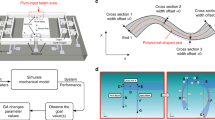Abstract
We propose a novel adaptive technique based on pseudo-random (PN) sequences for self-calibration and self-testing of MEMS-based inertial sensors (accelerometers and gyroscopes). The method relies on using a parameterized behavioral model implemented on FPGA, whose parameters values are adaptively tuned, based on the response to test pseudo-random actuation of the physical structure. Dedicated comb drives actuate the movable mass with binary maximum length pseudo-random sequences of small amplitude, to keep the device within the linear operating regime. The frequency of the stimulus is chosen within the mechanical spectral operating range of the micro-device, such that the induced response leads to the identification of the mechanical transfer function, and to the tuning of the associated digital behavioral model. In case of a micro-gyroscope, experimental results demonstrate the adaptive tracking of the damping coefficient from 5.57 × 10−5 Kg/s to 7.12 × 10−5 Kg/s and of the stiffness coefficient from 132 N/m to 137.7 N/m. In the case of a MEMS accelerometer, the damping and stiffness coefficients are correctly tracked from 3.4 × 10−3 Kg/s and 49.56 N/m to 4.57 × 10−3 Kg/s and 51.48 N/m, respectively—the former values are designer-specified target values, while the latter are experimentally measured parameters for fabricated devices operating in a real environment. Hardware resources estimation confirms the small area the proposed algorithm occupies on the targeted FPGA device.












Similar content being viewed by others
Notes
Portion of this Manuscript has appeared as a conference abstract (Kansal et al 2011[8])
References
Acar C, Shkel A (2005) An approach for increasing drive-mode bandwidth of MEMS vibratory gyroscopes. J Microelectromech Syst 14(3):520–528. doi:10.1109/JMEMS.2005.844801
Analog Devices inc, low-g accelerometers, ADXL326: Small, Low Power, 3-Axis ±16 g Accelerometer http://www.analog.com/en/mems/low-g-accelerometers/adxl326/products/product.html. Accessed 11 November 2010
Benoit C, Salvador M, Parrain F, Courtois B (2001) Electrically induced stimuli for MEMS self-test. 19th IEEE Proceedings on VLSI Test Symposium, VTS 2001. doi: 10.1109/VTS.2001.923441
Chapuis Y-A, Zhou L, Fukuta Y, Mita Y, Fujita H (2007) FPGA-based decentralized control of arrayed MEMS for microrobotic application. IEEE Trans Ind Electron 54(4):1926–1936. doi:10.1109/TIE.2007.898297
Deb Nilmoni, Blanton RD (Shawn) (2006) Built-In Self-Test of MEMS Accelerometers. J Microelectromech Syst 15(1):52–68. doi: 10.1109/JMEMS.2006.864239
Dhayni A, Mir S, Rufer L, Bounceur A, Simeu E (2009) Pseudorandom BIST for test and characterization of linear and nonlinear MEMS. Microelectron J 40(7):1054–1061. doi:10.1016/j.mejo.2008.05.012
Dumas N, Xu Z, Georgopoulos K, Bunyan R, Richardson A (2007) A novel approach for online sensor testing based on an encoded test stimulus, 12th IEEE European Test Symposium (ETS’07), 105–110. doi: 10.1109/ETS.2007.7
Kansal A, Sarraf EH, Sharma M, Cretu E (2011) Novel adaptive FPGA- based self-calibration and self-testing scheme with PN sequences for MEMS-based inertial sensors, IEEE 17th International Mixed-Signals, Sensors and Systems Test Workshop (IMS3TW), Santa Barbara, CA, May 15–18, 2011
Measurement Computing inc, USB Data Acquisition, Multifunction DAQ, USB 12-Bit Multifunction Solutions, USB-1208 Series, http://www.mccdaq.com/usb-data-acquisition/USB-1208-Series.aspx, Accessed 11 November 2010
Pan C-Y, Cheng K-T (1997) Pseudorandom testing for mixed-signal circuits. IEEE Trans Comput-Aid Des Integr Circ Syst 16(10):1173–1185. doi:10.1109/43.662678
Puers R, Reyntjens S (2002) RASTA-real-acceleration-for-self-test accelerometer: a new concept for self-testing accelerometers. Sensors Actuators A: Phys 97–98:359–368. doi:10.1016/S0924-4247(02)00023-7
Roushan R, Saha G, Boni A, Kal S (2006) FPGA implementation of an automobile pollution control system using a MEMS accelerometer. IEEE International Conference on Industrial Technology, 2006. ICIT 2006. doi: 10.1109/ICIT.2006.372467
Rufer L, Mir S, Simeu E, Domingues C (2005) On-chip pseudorandom MEMS testing. J Electron Test 21(3):233–241. doi:10.1007/s10836-005-6353-9
Sharma M, Sarraf EH, Cretu E (2011) Parametric amplification/damping in MEMS gyroscopes. IEEE 24th International Conference on Micro Electro Mechanical Systems, pp 617–620, doi: 10.1109/MEMSYS.2011.5734500
STMicroelectronics inc, Motion Sensors (MEMS), Accelerometers, LIS244, ALMEMS motion sensor 2-axis, ±2 g Ultracompact Analog Output Accelerometer, http://www.st.com/internet/analog/product/180471.jsp, Accessed 11 November 2010
Xiong X, Wu Y-L, Jone W-B (2005) A dual-mode built-in self-test technique for capacitive MEMS devices. IEEE Trans Instrum Meas 54(5):1739–1750. doi:10.1109/TIM.2005.855094
Acknowledgment
The authors would like to thank CMC Microsystems, MITACS, Auto21 Network of Centres of Excellence, and the Natural Sciences and Engineering Research Council of Canada (NSERC) for making this research possible.
Author information
Authors and Affiliations
Corresponding author
Additional information
Responsible Editor: D. Keezer
Rights and permissions
About this article
Cite this article
Sarraf, E.H., Kansal, A., Sharma, M. et al. FPGA-based Novel Adaptive Scheme Using PN Sequences for Self-Calibration and Self-Testing of MEMS-based Inertial Sensors. J Electron Test 28, 599–614 (2012). https://doi.org/10.1007/s10836-012-5336-x
Received:
Accepted:
Published:
Issue Date:
DOI: https://doi.org/10.1007/s10836-012-5336-x




